 

 |
|
|
The Town of Chatsworth had its beginnings on March 8, 1888, when George R. Crow filed a map of a subdivision called Chatsworth Park with the Los Angeles County Recorder's Office. The land had been surveyed in 1887 by Charles T. Healey and William F. Sweeney. According to the map, Chatsworth Park was planned as an agricultural community with the land divided into ten-acre family plots. Three streets were shown on the map, including Ben Porter Avenue, Devonshire Avenue, and Fernando Avenue.
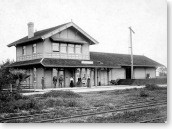 The first of the three avenues had been named in honor of Benjamin F. Porter who owned the Granger Ranch, one of the original thirteen ranches into which the San Fernando Valley had been divided. Seven of these ranches were located in the southern half of the valley, and six were in the northern half. The Granger Ranch, located in the northern half, would make up part of Chatsworth Park. Devonshire Avenue was named in honor of England's Duke of Devonshire whose country estate, located in Derby County, is called Chatsworth House. Fernando Avenue was named after the valley of which Chatsworth is a part. On August 31, 1893, W.B. Barber, president of the San Fernando Valley Improvement Company, filed another map with the Los Angeles County Recorder's Office entitled Plat of Chatsworth Park Townsite. The second map differed from the first in that it included a railroad station, a Main Street, and a shopping area. Chatsworth is located to the southeast of the Santa Susana Pass, an extremely steep mountain pass that stagecoaches had to negotiate when traveling the Overland Stage Road from Los Angeles to San Francisco. Santa Susana became a relay station for the stagecoach lines where drivers would trade in their tired horses before attempting to traverse the steep Overland Stage Road. As a result of its proximity to a relay station, Chatsworth became an important town in the transportation history of California.
The first of the three avenues had been named in honor of Benjamin F. Porter who owned the Granger Ranch, one of the original thirteen ranches into which the San Fernando Valley had been divided. Seven of these ranches were located in the southern half of the valley, and six were in the northern half. The Granger Ranch, located in the northern half, would make up part of Chatsworth Park. Devonshire Avenue was named in honor of England's Duke of Devonshire whose country estate, located in Derby County, is called Chatsworth House. Fernando Avenue was named after the valley of which Chatsworth is a part. On August 31, 1893, W.B. Barber, president of the San Fernando Valley Improvement Company, filed another map with the Los Angeles County Recorder's Office entitled Plat of Chatsworth Park Townsite. The second map differed from the first in that it included a railroad station, a Main Street, and a shopping area. Chatsworth is located to the southeast of the Santa Susana Pass, an extremely steep mountain pass that stagecoaches had to negotiate when traveling the Overland Stage Road from Los Angeles to San Francisco. Santa Susana became a relay station for the stagecoach lines where drivers would trade in their tired horses before attempting to traverse the steep Overland Stage Road. As a result of its proximity to a relay station, Chatsworth became an important town in the transportation history of California.
In 1893, the Chatsworth Train Depot was built near the intersection of Marilla and Topanga Canyon Roads, thus expanding the economy of the burgeoning town in a variety of ways. Initially, the railroad enabled farmers to reach a broader market to sell their crops. Because of the mountainous terrain however, Southern Pacific
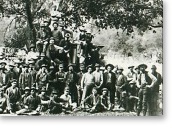 Railroad had to construct three tunnels (Numbers 26, 27 and 28), all of which were bored through sandstone. During the construction of the Chatsworth Tunnels from 1898 to 1904, the town of Chatsworth became one of the busiest places in the valley. Men came from all around the country to work on the three tunnels built for Southern Pacific's Montalvo Cutoff, the
new Coast Line connection from Ventura to Burbank. Approximately twenty miles of new track were put down across the San Fernando Valley between Chatsworth and the new Burbank Junction. Of the three tunnels, the longest and westernmost is Tunnel #26, which measures 7,369 feet in length. It cuts through the Santa Susana Mountains and borders the southern edge of Corriganville Regional Park underneath the Santa Susana Pass where horse-drawn coaches once
Railroad had to construct three tunnels (Numbers 26, 27 and 28), all of which were bored through sandstone. During the construction of the Chatsworth Tunnels from 1898 to 1904, the town of Chatsworth became one of the busiest places in the valley. Men came from all around the country to work on the three tunnels built for Southern Pacific's Montalvo Cutoff, the
new Coast Line connection from Ventura to Burbank. Approximately twenty miles of new track were put down across the San Fernando Valley between Chatsworth and the new Burbank Junction. Of the three tunnels, the longest and westernmost is Tunnel #26, which measures 7,369 feet in length. It cuts through the Santa Susana Mountains and borders the southern edge of Corriganville Regional Park underneath the Santa Susana Pass where horse-drawn coaches once
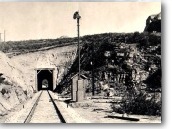 labored up the slopes that physically connected the San Fernando and Simi Valleys. For this reason, Tunnel #26 is often referred to as the Santa Susana Tunnel. Tunnels #27 and #28 are much shorter in length. The latter and easternmost, Tunnel #28 is located under Topanga Canyon Boulevard just across the entrance to Iverson Ranch, and is the most easily recognizable on the movie screen. Tunnel #27 is located between the other two tunnels and directly northeast of Chatsworth Park South. During the construction of the three Tunnels, the sandstone formations were blasted into large boulders that were later used in the construction of the San Pedro Breakwater. From Chatsworth, the boulders were loaded onto flat-cars and transported by rail via the newly laid Burbank branch heading south through Los Angeles.
labored up the slopes that physically connected the San Fernando and Simi Valleys. For this reason, Tunnel #26 is often referred to as the Santa Susana Tunnel. Tunnels #27 and #28 are much shorter in length. The latter and easternmost, Tunnel #28 is located under Topanga Canyon Boulevard just across the entrance to Iverson Ranch, and is the most easily recognizable on the movie screen. Tunnel #27 is located between the other two tunnels and directly northeast of Chatsworth Park South. During the construction of the three Tunnels, the sandstone formations were blasted into large boulders that were later used in the construction of the San Pedro Breakwater. From Chatsworth, the boulders were loaded onto flat-cars and transported by rail via the newly laid Burbank branch heading south through Los Angeles.
In 1917, the original Chatsworth Train Depot burned down. By that time, however, a newer and larger station had been erected on the west side of the tracks between Devonshire and Lassen Streets. It was this second depot that has been featured so prominently in films. In 1962, Southern Pacific announced it would tear down the building due to the lack of traffic. Although residents petitioned to preserve the depot as a historical site, railroad crews arrived during the night and destroyed it.
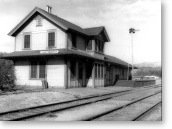 For the next two decades, the Chatsworth train stop, like other Southern California commuter train stops, consisted merely of an outdoor, open-air platform where people waited in either pouring rain or scorching heat. Even though trains continued to make regular stops there, in 1990 Southern Pacific declared its intentions to build a lumberyard at the site. The decision prompted immediate protests from residents, and this time they would be victorious in their cause. Coincidently, the MTA (Metro Transit Authority) was in the process of forming Metrolink, and stops were needed for the new commuter train service. The MTA, in partnership with the City of Los Angeles, used an $8 million grant from the state to buy the property from Southern Pacific. Following the land acquisition, a citizen advisory board was created to help formulate a master plan for the new project. In 1992, a new passenger platform was built directly across the tracks from the second depot site to accommodate the Metrolink commuter service. The construction of a depot building soon followed. Built in an Old West style, the new depot reflects Chatsworth's historical significance as a stagecoach stop in the 19th century, as well as the place where many movies, serials and television shows had been filmed. It was dedicated in a public ceremony in April 1996, with former Chatsworth resident celebrities Roy Rogers and Dale Evans in attendance.
For the next two decades, the Chatsworth train stop, like other Southern California commuter train stops, consisted merely of an outdoor, open-air platform where people waited in either pouring rain or scorching heat. Even though trains continued to make regular stops there, in 1990 Southern Pacific declared its intentions to build a lumberyard at the site. The decision prompted immediate protests from residents, and this time they would be victorious in their cause. Coincidently, the MTA (Metro Transit Authority) was in the process of forming Metrolink, and stops were needed for the new commuter train service. The MTA, in partnership with the City of Los Angeles, used an $8 million grant from the state to buy the property from Southern Pacific. Following the land acquisition, a citizen advisory board was created to help formulate a master plan for the new project. In 1992, a new passenger platform was built directly across the tracks from the second depot site to accommodate the Metrolink commuter service. The construction of a depot building soon followed. Built in an Old West style, the new depot reflects Chatsworth's historical significance as a stagecoach stop in the 19th century, as well as the place where many movies, serials and television shows had been filmed. It was dedicated in a public ceremony in April 1996, with former Chatsworth resident celebrities Roy Rogers and Dale Evans in attendance.
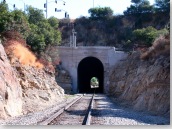 Over the years, Chatsworth Train Depot and Tunnels have served as more than just a transportation hub for people; they have also been used as film location backdrops in a number of movies and serials. While they have been used in a variety of motion picture genres, the Depot and Tunnels have appeared most frequently in the once popular B-Westerns and serial cliffhangers of yesteryear. With its terrain strewn with house-size boulders against the backdrop of the Santa Susana Mountains, Chatsworth fit the popular conception of the American West, and its proximity to Hollywood made it a highly desirable film locale for rural western scenes. Because Tunnel #28 goes underneath Topanga Canyon Boulevard just across the entrance to Iverson Ranch, it was easy for production crews to film action scenes such as jumping onto the top of a moving locomotive or the transition of a train entering or exiting a tunnel. Both of these types of scenes add depth and quality to films. Movies that have included either the Chatsworth Train Depot or the Chatsworth Tunnels as a location site include Cecil B. DeMille's The Squaw Man (1914) starring Dustin Farnum and Monroe Salisbury; 20th Century Fox's musical comedy Pigskin Parade (1936) starring Jack Haley and Judy Garland (her first feature film); Paramount Pictures' Technicolor remake of Harry Leon Wilson's venerable comedy Fancy Pants (1950)
Over the years, Chatsworth Train Depot and Tunnels have served as more than just a transportation hub for people; they have also been used as film location backdrops in a number of movies and serials. While they have been used in a variety of motion picture genres, the Depot and Tunnels have appeared most frequently in the once popular B-Westerns and serial cliffhangers of yesteryear. With its terrain strewn with house-size boulders against the backdrop of the Santa Susana Mountains, Chatsworth fit the popular conception of the American West, and its proximity to Hollywood made it a highly desirable film locale for rural western scenes. Because Tunnel #28 goes underneath Topanga Canyon Boulevard just across the entrance to Iverson Ranch, it was easy for production crews to film action scenes such as jumping onto the top of a moving locomotive or the transition of a train entering or exiting a tunnel. Both of these types of scenes add depth and quality to films. Movies that have included either the Chatsworth Train Depot or the Chatsworth Tunnels as a location site include Cecil B. DeMille's The Squaw Man (1914) starring Dustin Farnum and Monroe Salisbury; 20th Century Fox's musical comedy Pigskin Parade (1936) starring Jack Haley and Judy Garland (her first feature film); Paramount Pictures' Technicolor remake of Harry Leon Wilson's venerable comedy Fancy Pants (1950)
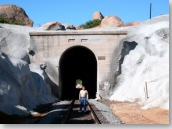 starring Bob Hope and Lucille Ball; and my favorite Allied Artists' sci-fi cult classic Invasion of the Body Snatchers (1956), directed by Don Siegel and starring Kevin McCarthy and Dana Wynter. In George Marshall's Fancy Pants (1950), the Chatsworth Tunnel can be seen in the film's finale as Bob Hope and Lucille Ball ride a hand-operated railcar
into one of the tunnels, unsuspectingly against an incoming train. Imminent catastrophe turns into rollicking comedy when the railcar exits the tunnel in two equal pieces, each commandeered by one of the stars. In Don Siegel's Invasion of the Body Snatchers (1956), the Chatsworth Train Depot appears early in the film as the story unfolds in flashback. Upon returning from a medical convention, Dr. Miles Bennel (Kevin McCarthy) is picked up at the Santa Mira (Chatsworth) Train Depot by his girlfriend, Becky Driscoll (Dana Wynter), and learns that a crowd of people have jammed his office complaining that their loved ones are acting extremely strange.
starring Bob Hope and Lucille Ball; and my favorite Allied Artists' sci-fi cult classic Invasion of the Body Snatchers (1956), directed by Don Siegel and starring Kevin McCarthy and Dana Wynter. In George Marshall's Fancy Pants (1950), the Chatsworth Tunnel can be seen in the film's finale as Bob Hope and Lucille Ball ride a hand-operated railcar
into one of the tunnels, unsuspectingly against an incoming train. Imminent catastrophe turns into rollicking comedy when the railcar exits the tunnel in two equal pieces, each commandeered by one of the stars. In Don Siegel's Invasion of the Body Snatchers (1956), the Chatsworth Train Depot appears early in the film as the story unfolds in flashback. Upon returning from a medical convention, Dr. Miles Bennel (Kevin McCarthy) is picked up at the Santa Mira (Chatsworth) Train Depot by his girlfriend, Becky Driscoll (Dana Wynter), and learns that a crowd of people have jammed his office complaining that their loved ones are acting extremely strange.
In the B-Western category, Chatsworth Train Depot and Tunnels can be seen in such oaters as Monogram Pictures' The Trail Beyond (1934) starring John Wayne and Verna Hillie, and Columbia Pictures' The Stranger from Arizona (1938) starring Buck Jones and Dorothy Fay. Serial aficionados will recognize these locations (in either real or stock footage)
in several classic cliffhangers including Dick Tracy vs. Crime Inc. (1941), King of the Texas Rangers (1941), Superman (1948), Batman and Robin (1949), Government Agents vs. Phantom Legion (1951), Radar Men from the Moon (1952) and Zombies of the Stratosphere (1952). In Columbia Pictures' 15-chapter serial Batman
and Robin (1949), Tunnel #28 shows up at the end of Chapter 2's "Tunnel of Terror" when Batman, in a death-defying cliffhanger scene, fights the Wizard on top of a train and meets with near demise as the speeding train approaches the tunnel.
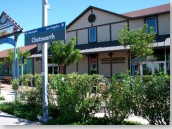 In predictable fashion, Batman survives this near-fatal catastrophe at the beginning of Chapter 3, "Robin's Wild Ride", and goes on to outwit the Wizard for the remainder of the serial's chapters.
In predictable fashion, Batman survives this near-fatal catastrophe at the beginning of Chapter 3, "Robin's Wild Ride", and goes on to outwit the Wizard for the remainder of the serial's chapters.
Today, the Chatsworth Station has become a transport hub for those traveling to the western part of San Fernando Valley and beyond. Located at the Old Depot Plaza Road and Devonshire Street, the station is a stop for both Amtrak Intercity and Metrolink Commuter trains. It can be reached by local transit, and offers parking for hundreds of cars and bicycle racks for cyclists. Chatsworth Station houses the area's City Councilman's Office, the Chatsworth Chamber of Commerce, a day-care center, a snack bar in the main building, and even a bicycle store. From Los Angeles, go north on Interstate 101, exit on Topanga Canyon Boulevard and turn right. Turn left on Santa Susana Pass Road and then right on Lassen Street. Turn left on Canoga Avenue and the Metrolink Station is located at 10040 Old Depot Plaza Road.
|
| |
 |
|